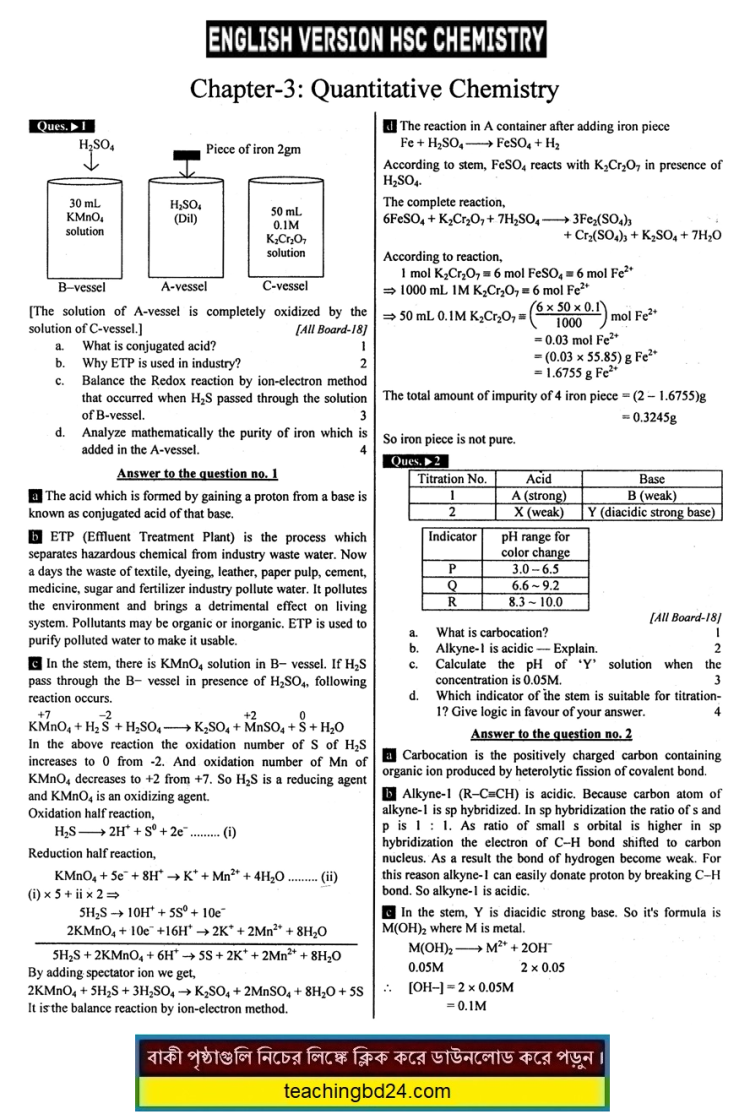HSC EV Chemistry 2nd Paper 3rd Chapter Note. Quantitative Chemistry. Quantitative chemistry is a very important branch of chemistry because it enables chemists to calculate known quantities of materials. For example, how much product can be made from a known starting material or how much of a given component is present in a sample? Quantitative analysis is any method used for determining the amount of a chemical in a sample.
The amount is always expressed as a number of appropriate units. An acid-base titration is an example of quantitative analysis. In this module, you will learn about the core ideas or building blocks that are required for a deep understanding of quantitative chemistry. You will start to appreciate how relatively simple ideas develop and progress to more complex calculations as more knowledge is acquired. This line of progression is clearly seen in the thread of ideas, which may be used as a point of reference.
Study of properties includes both physical properties and chemical properties, and uses similar methods as well as methods to evaluate chemical reactivity, with the aim to understand the behavior of the organic matter in its pure form (when possible), but also in solutions, mixtures, and fabricated forms. The study of organic reactions includes probing their scope through use in preparation of target compounds (e.g., natural products, drugs, polymers, etc.) by chemical synthesis, as well as the focused study of the reactivities of individual organic molecules, both in the laboratory and via theoretical (in silico) study.
HSC EV Chemistry 2nd Paper 3rd Chapter Note. Quantitative Chemistry



The classical procedure for the complete systematic analysis of an inorganic sample consists of several parts. First, a preliminary dry test may be performed, which may consist of heating the sample to detect the presence of such constituents as carbon (marked by the appearance of smoke or char) or water (marked by the appearance of moisture) or introducing the sample into a flame and noting the color produced. Certain elements may be identified by means of their characteristic flame colors. After preliminary tests have been performed, the sample is commonly dissolved in water for later determination of anionic constituents (i.e., negatively charged elements or groupings of elements) and cationic constituents (i.e., positively charged elements or groupings of elements).
The procedure followed is based on the principle of treating the solution with a succession of reagents so that each reagent separates a group of constituents. The groups are then treated successively with reagents that divide a large group into subgroups or separate the constituents singly. When a constituent has been separated it is further examined to confirm its presence and to establish the amount present (quantitative analysis). Portions of the material are dissolved separately, and different procedures are used for each to detect the cationic and anionic constituents
In many countries, laboratory work is subject to health and safety legislation. In some cases, laboratory activities can also present environmental health risks, for example, the accidental or deliberate discharge of toxic or infective material from the laboratory into the environment. All students must read and understand the information in this docomeent with regard to laboratory safety and emergency procedures prior to the first laboratory session. Your personal laboratory safety depends mostly on YOU. The effort has been made to address situations that may pose a hazard in the lab but the information and instructions provided cannot be considered all-inclusive.
Environmental chemistry is the study of chemical processes occurring in the environment which are impacted by humankind’s activities. These impacts may be felt on a local scale, through the presence of urban air pollutants or toxic substances arising from a chemical waste site, or on a global scale, through depletion of stratospheric ozone or global warming. The focus in our courses and research activities is upon developing a fundamental understanding of the nature of these chemical processes so that humankind’s activities can be accurately evaluated.
teachingbd24.com is such a website where you would get all kinds of necessary information regarding educational notes, suggestions and questions’ patterns of school, college, and madrasahs. Particularly you will get here special notes of physics that will be immensely useful to both students and teachers. The builder of the website is Mr. Md. Shah Jamal Who has been serving for 30 years as an Asst. Professor of BAF Shaheen College. He expects that this website will meet up all the needs of Bengali version learners /students. He has requested both concerned students and teachers to spread this website home and abroad.
English Version HSC Chemistry Note
Discover more from Teaching BD
Subscribe to get the latest posts sent to your email.

